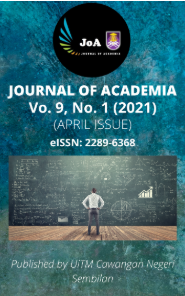EVALUATION OF SELECTED HERBS EXTRACT AS REPELLENT AGAINST RUBBER TERMITES (Coptotermes curvignathus)
Keywords:
termites’ repellen, repellency activity, herb extraction, Coptotermes curvignathusAbstract
Termites encompass a various range of destruction of crops and capable of decomposing woods. The widely being used of hazardous chemical pesticides has develop many health problems to the users. Hence, the aim of this study was to substitute the use of hazardous chemical pesticides to herbs based pesticides as repellent agent against rubber termites (Coptotermes curvignathus), which is safer and easier to use. The selected herbs species for this study are lemongrass (Cymbopogon citratus), garlic (Allium sativum) and wild mint (Mentha arvensis). As for C.curvignathus, they were obtained from Forest Research Institute Malaysia (FRIM), Kepong, Selangor, Malaysia. Khaya wood (Khaya senegalensis) (3cm x 2cm x 2cm) is the woods sample that being used. All woods samples were treated with all the selected herbs extract. The repellent testing was conducted for 21 days. The result obtained showed that the three herbs were effective to be used as repellent when compared to percentage weight loss of control, which is 23.58%. The percentages of weight loss of treated groups using aqueous extraction of herbs were 0.61% (lemongrass), 1.56% (mint), and 1.72% (garlic), whereas for methanol extraction of herbs were 0.52% (lemongrass), 1.13% (mint) and 1.55% (garlic). From Analysis of Variance (ANOVA), there is significant different in mean among group with F=275.49, p-value=0.000<0.05.
References
Aiman, H. J., Hassan, A. A., Nurita A., Che Salmah M. R. (2014). Community structure of termites in a hill dipterocarp forest of Belum– Temengor Forest Complex, Malaysia: emergence of pest species. Raffles Buletin Of Zoology, 3-11.
Baidoo, P. K., Mochiah, M. B. and Apusiga, K. (2012). Onion as a pest control intercrop in organic cabbage (Brassica oleracea) production system in Ghana. Journal of Sustainable Agricultural Research, 1(1), 36-41.
Donovan, S. E., Eggleton, P. and Bignell, D. E. (2011). Gut content analysis and a new feeding group classification of termites. Ecological Entomology, 356-366.
Hafiz, A. M. and Hassan, A. A. (2015). Define colony number of Subterranean Termites Coptotermes gestroi (Isoptera: Rhinotermitidae) in selected infested structures. Sains Malaysiana, 44(2), 211–216.
Katsaruware, R. D. and Dubiwa, M. (2014). Onion (Allium cepa) and garlic (Allium sativum) as pest control intercrops in cabbage based intercrop systems in Zimbabwe. IOSR Journal of Agriculture and Veterinary Science, 7(2), 13-17.
Kirton, L. G. and Cheng, S. (2007). Ring-Barking and Root Debarking of Diptera sampling by termites in an enrichment planting site in Malaysia. Journal of Tropical Forest Science, 19(2), 67-72.
Maayiem, D., Baatuuwie, N. B. and Aalangdong, O. I. (2012). Indigenous knowledge of termite control: A case study of five farming communities in Gushegu District of Northern Ghana. Journal of Entomology and Nematology, 4(6), 58-64.
Maia, F. M. and Moore, J. S. (2011). Plant-based insect repellents: a review of their efficacy, development and testing. Malaria Journal, 10(11), 1-14.
Nur Ain. A. H., Zaibunnisa, A. H., Halimahton Zahrah, M. S. and Norashikin, S. (2013). An experimental design approach for the extraction of lemongrass (Cymbopogon citratus) oleoresin using pressurized liquid extraction (PLE). International Food Research Journal, 20(1), 451-455.
Odey, M. O., Iwara, I. A., Udiba, U. U., Johnson, J. T., Inekwe, U. V., Asenye, M. E., Victor, O. (2012). Preparation of plant extracts from indigenous medicinal plants. International Journal of Science and Technology, 1(12), 688-692.
Olorunnisola, S. K., Asiyanbi, H. T., Hammed, A. M. and Simsek, S. (2014). Biological properties of lemongrass: An overview. International Food Research Journal, 21(2), 455-462.
Olufemi, A. S., Gabriel, O. Y., Bamidele, D. Z. and Usman, A. (2011). Termiticidal effect of neem extracts on the wood of Khaya senegalensis. Research Journal of Forestry, 5(3), 128-138.
Qasim, M., Yongwen, L., Dalin, F. and Liande, W. (2015). Termites and microbial biological control strategies. South Asia Journal of Multidisciplinary Studies, 1(6), 33-62.
Sarwar, M. (2015). The dangers of pesticides associated with public health and preventing of the risks. International Journal of Bioinformatics and Biomedical Engineering, 1(2), 130-136.
Sowmya, S. N., Calistus, J. A. L. and Deepa, M. A. (2016). Anti-termite properties of four selected species of Zingiberaceae rhizome extracts. The Journal of Zoology Studies, 3(2), 24-29.
Steven, F. S. (2009). Analysis of Variance: The fundamental concepts. The Journal of Manual & Manipulative Therapy, 17(2), 27-38.
Verma, M., Sharma, S. and Malik, A. (2016). Termiticidal and repellency efficacy of botanicals against Odontotermes obesus. International Journal of Research in Biosciences, 5(2), 52-59.
Verma, M. Sharma, S. and Prasad, R. (2009). Biological alternatives for termite control: A review. International Biodeterioration & Biodegradation, 63(8):959-972.
Downloads
Published
Issue
Section
License
Copyright (c) 2021 Journal of Academia

This work is licensed under a Creative Commons Attribution-NonCommercial-NoDerivatives 4.0 International License.












